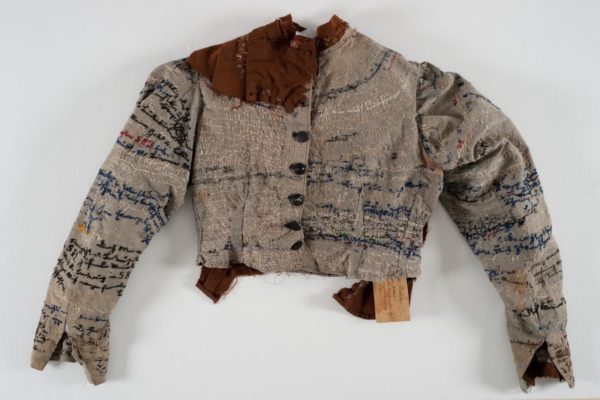Within The Fashion System Roland Barthes puts forth the notion that meaning from fashion can only be obtained by its relationship to image and text. The illegibility of the garment itself however, does not imply that said garment does not have meaning; only that it is obscured. This notion is interesting to consider in relation to an embroidered straitjacket produced by the psychosis of Agnes Richter within the confines of the Hubertusberg Psychiatric Institution in 1895. Various words and incoherent sentences are maniacally stitched upon every available space while visible perspiration stains map the contours of the jacket. This sense of corporeality gives a ghostly impression of the artist’s body and hand; a hand that punctured and stitched the very garment that restricted her. For Richter, the needle became the phallus that she, as a woman, was deprived of within the patriarchal structures of the 19th century sanatorium. The needle-qua-phallus operates as an object that gave Richter a mode of expression, whilst the jacket itself — designed to restrict the arms thus inhibiting the ability to sew — can be seen as an object of castration. The puncturing of the jacket thus becomes an act of aggression that enabled Richter to conquer the object of castration while simultaneously embedding herself within it.
Within her book Agnes’ Jacket, Gail A. Hornstein closely analyses the textual content of the straitjacket and ultimately concludes that it remains illegible to the viewer. Written in German in a style called Deutsch Schrift, the jacket’s musings have never been discerned from the erratic stitchings that line the topography of the garment. What can be deduced however, lies within the abstract nature of the piece; such as the unravelling and withering threads that represent the decomposition of the artist’s mind during the jacket’s production. What Hornstein ultimately concludes is that the ghostly corporeality of the garment comes to embody Agnes and allows the viewer to revel in the obscurity of trying to ascertain who she was.
This obscurity and illegibility, in relation to Barthes’ statements on fashion, provides interesting insight into the gendering of language as well as Richter’s rejection of it. Whilst Barthes claims that language is one of the vessels through which fashion can convey meaning, language itself —as explored by Lacan — is a patriarchal structure that signifies a child’s entry into the Symbolic Order. It is therefore no surprise that Richter, alongside many of her contemporary female patients, rejected language and relied upon other means of expression. Charcot’s hysterics, for example, relied upon contortions of the body while Richter utilized the needle and thread as a means of communication. The similarity that lies between the words ‘text’ and ‘textile’ is one that becomes divided when considering the gendering of each. The written word was a privilege predominantly gifted to men while women were often delegated to crafts such as embroidery and weaving. In rejecting language Richter makes a return to the feminine art of embroidery that ultimately subverts and obscures meaning. Trying to unravel the threads of Richter’s jacket is a task that no one seems to be equipped for; and it is in this rejection of the symbolic that allows Richter to speak in a voice that no one understands but everyone wants to listen to.
Further reading:
Roland Barthes, The Fashion System
Gail A. Hornstein, Agnes’ Jacket
Jacques Lacan, The Language of the Self
By Niall Billings


